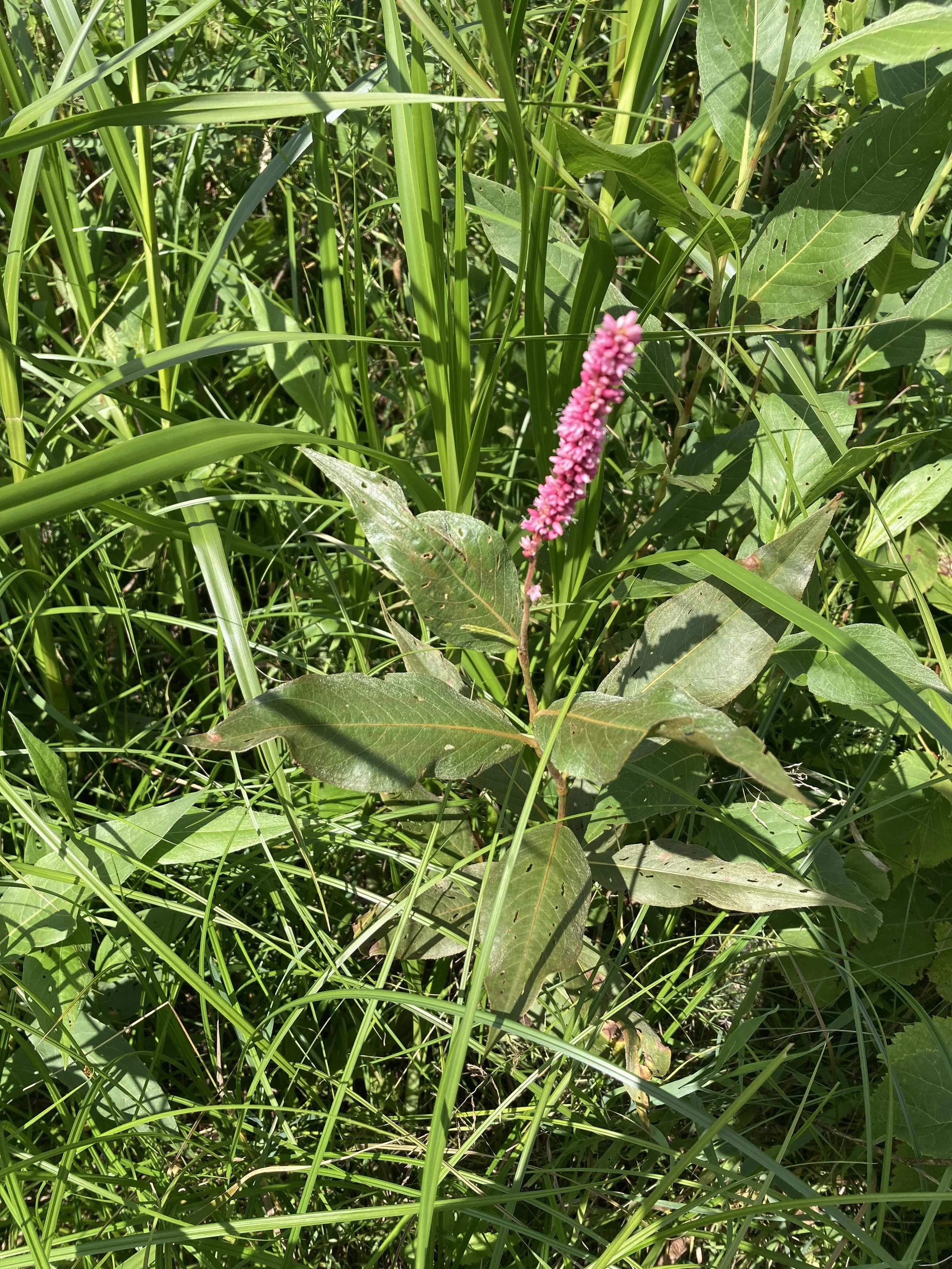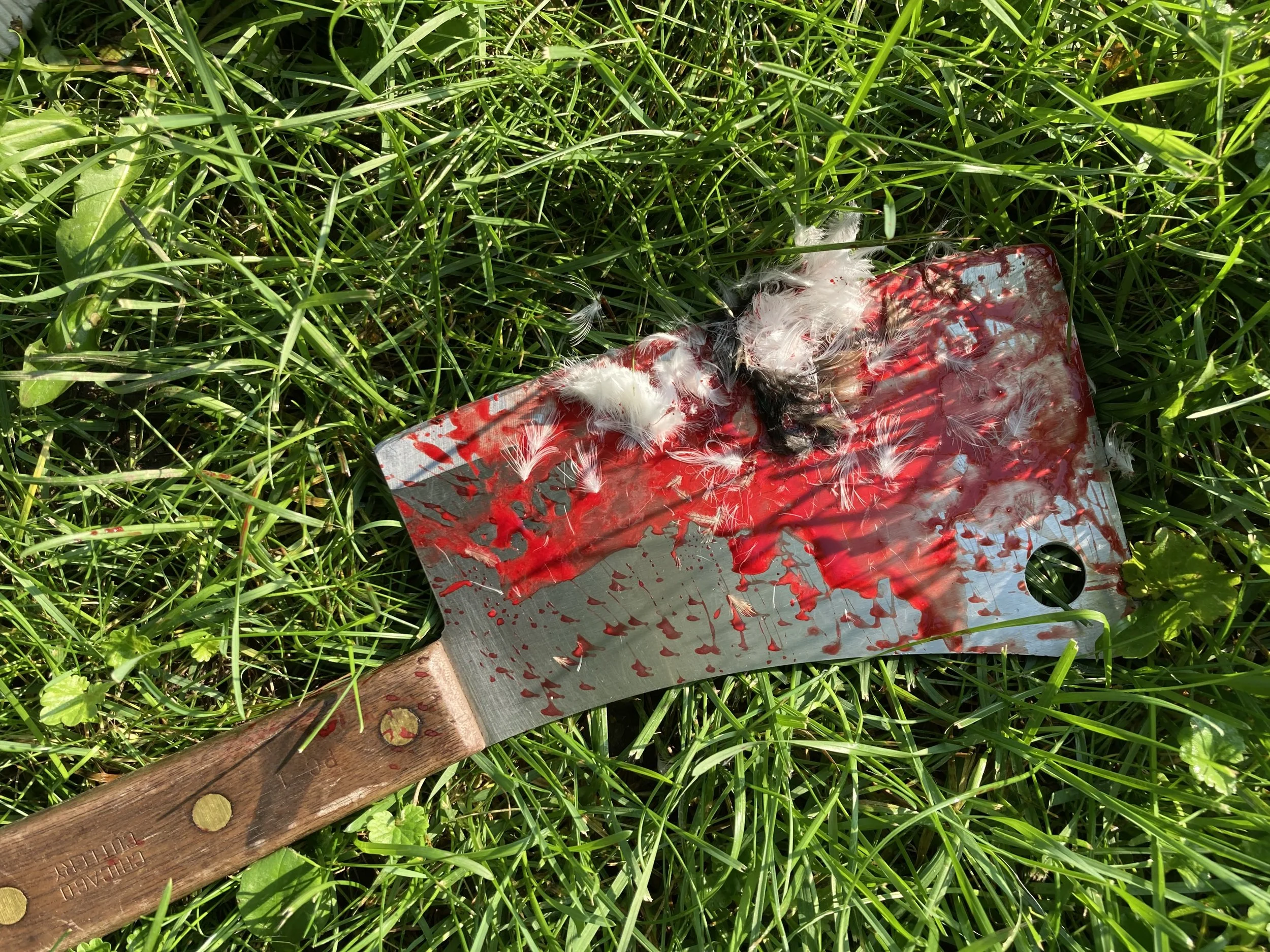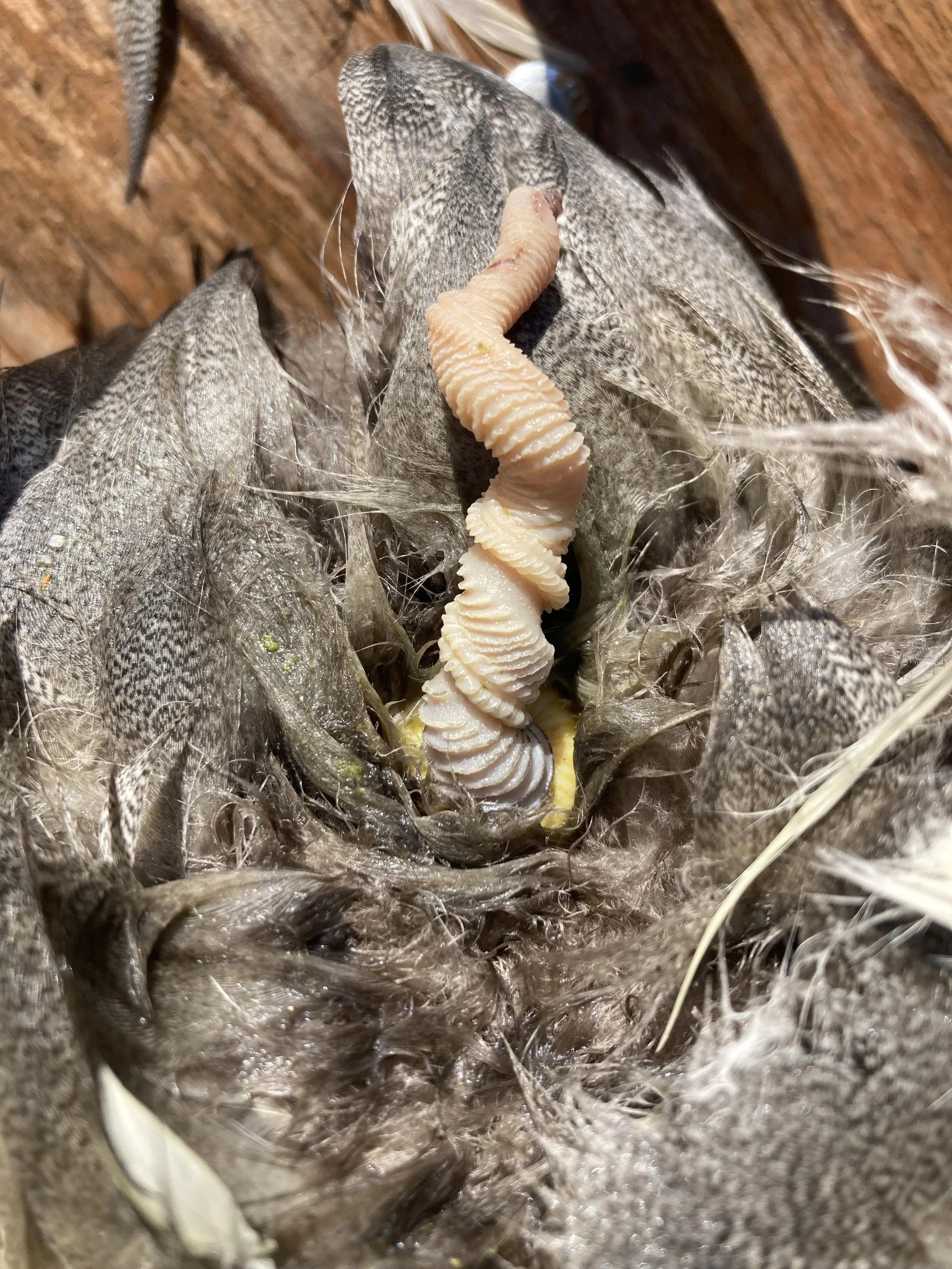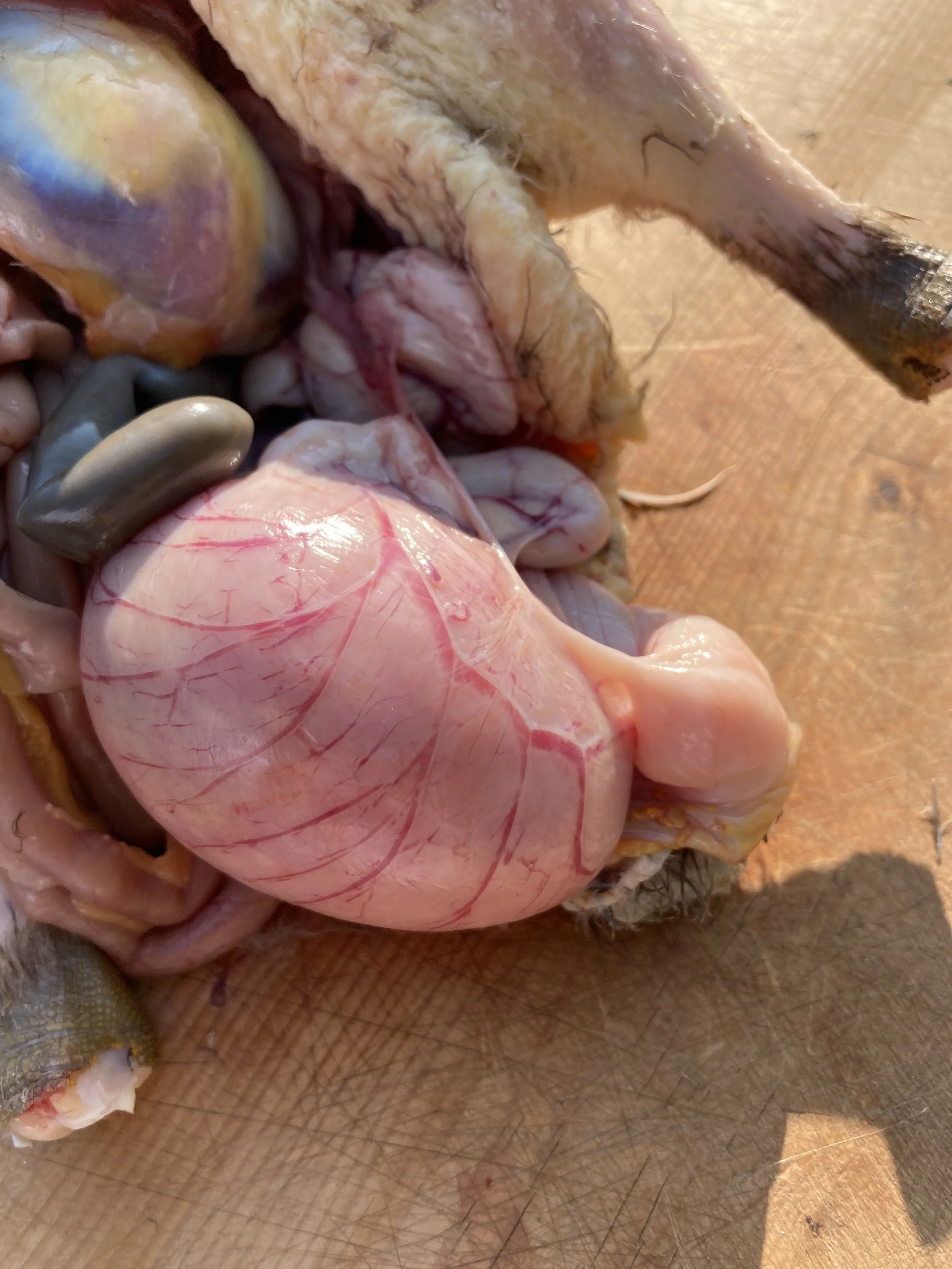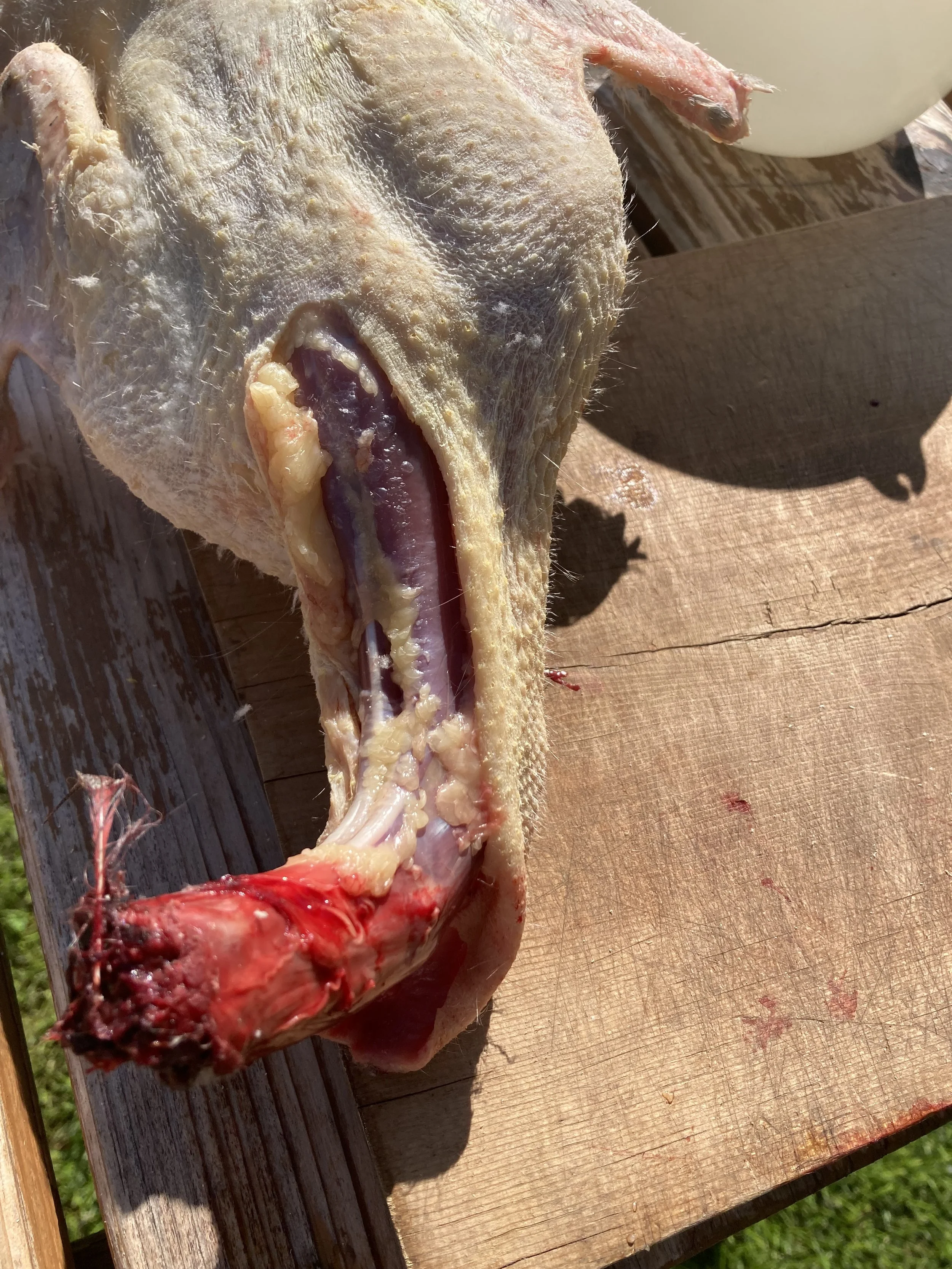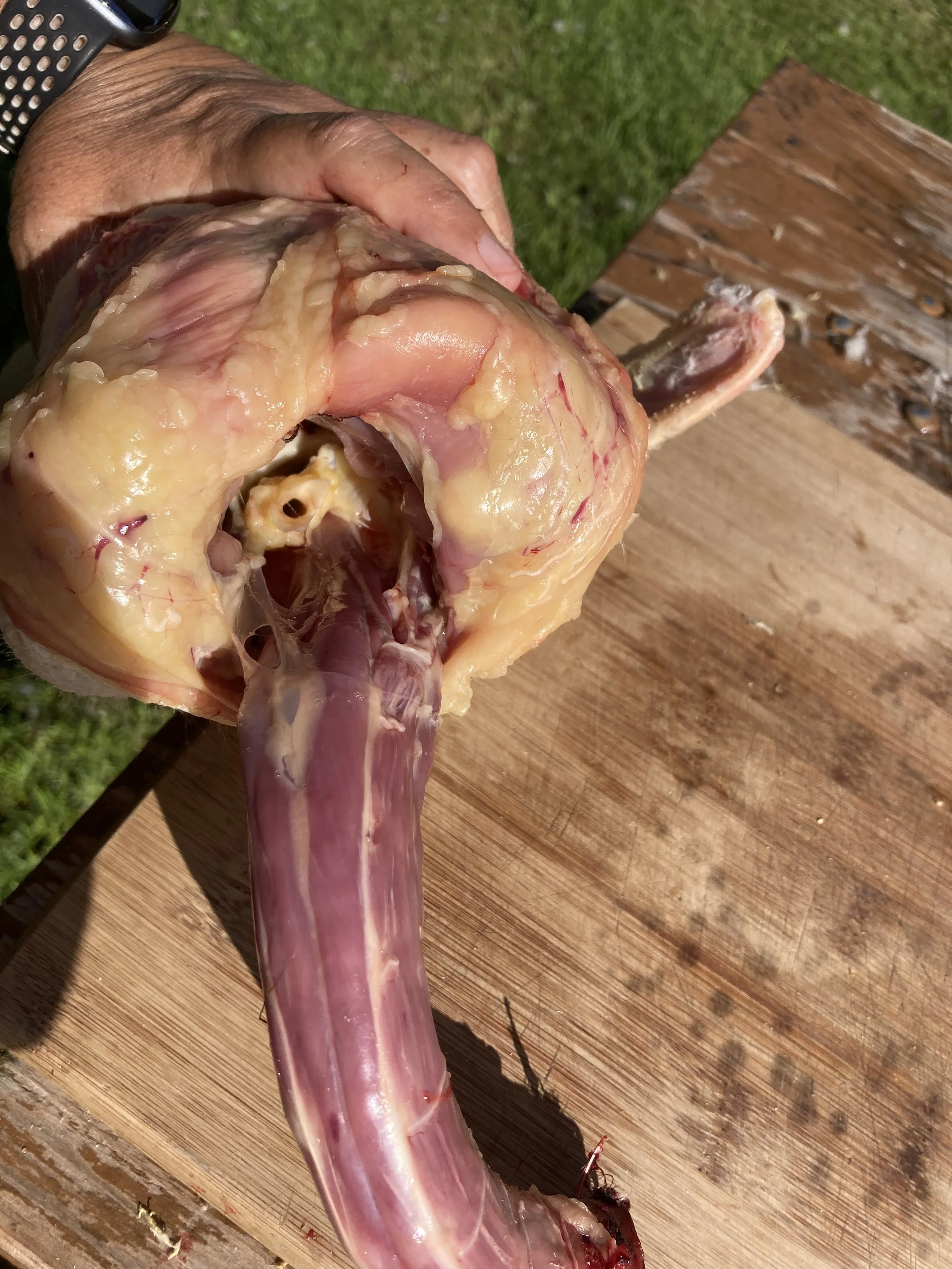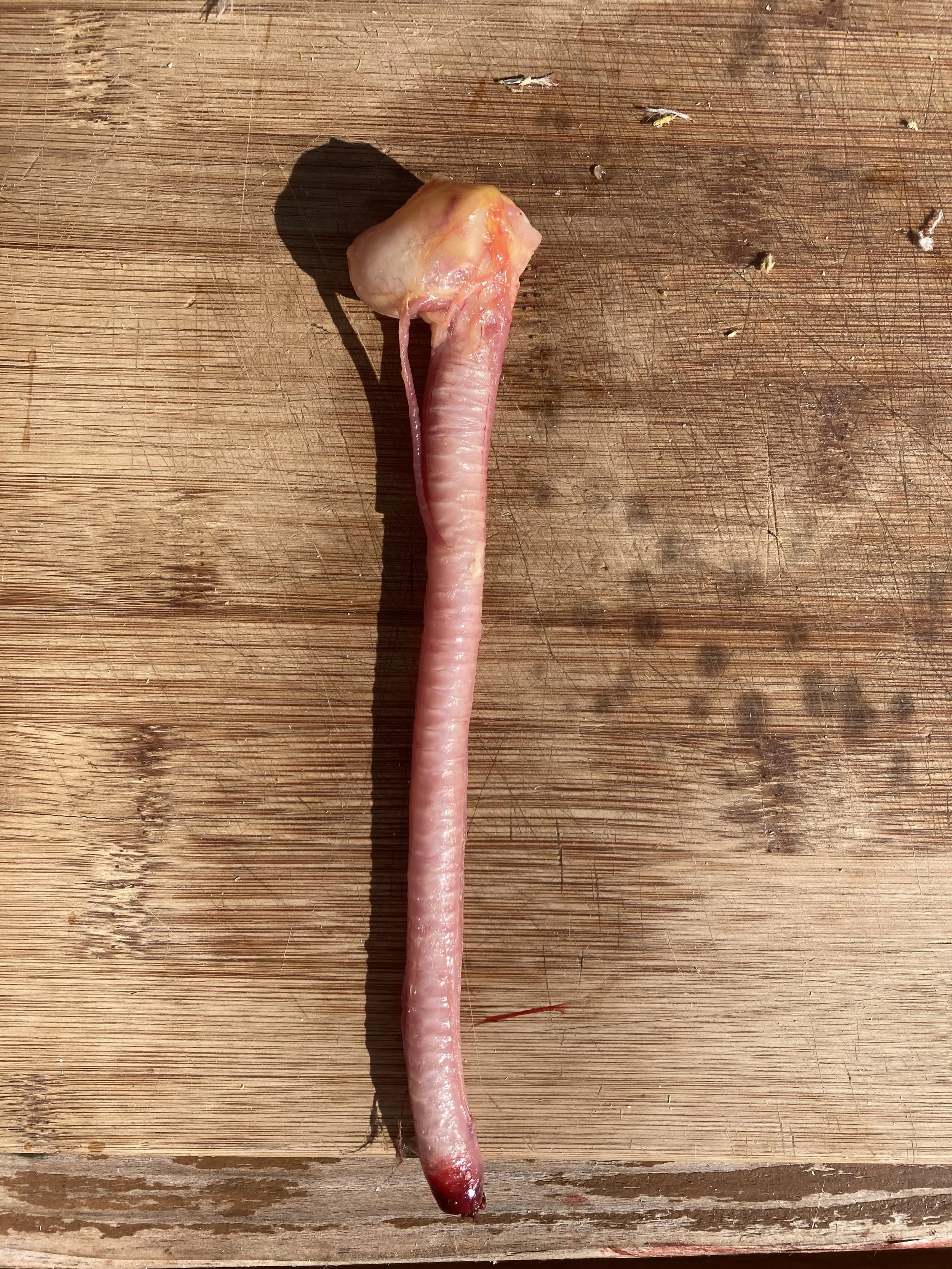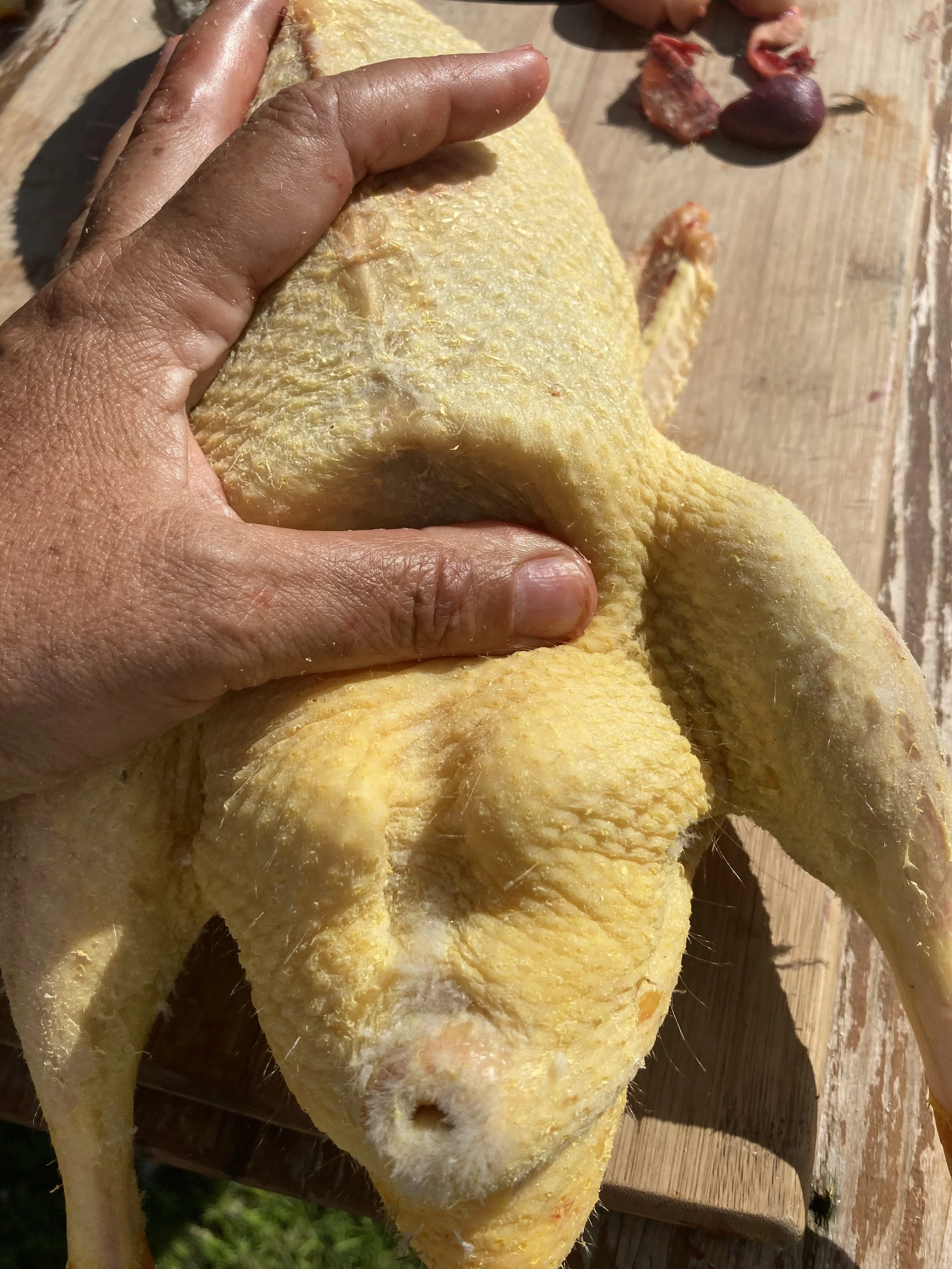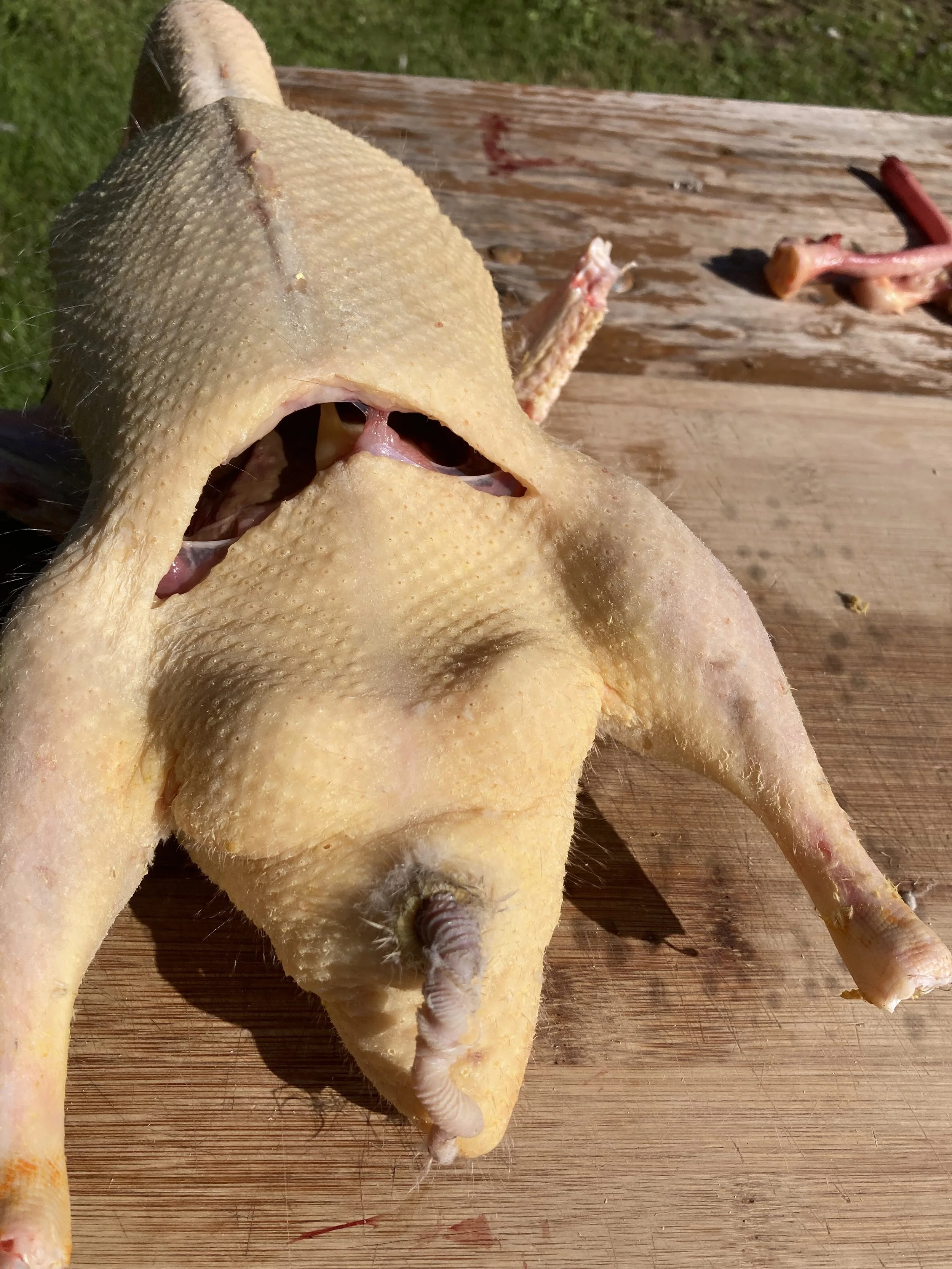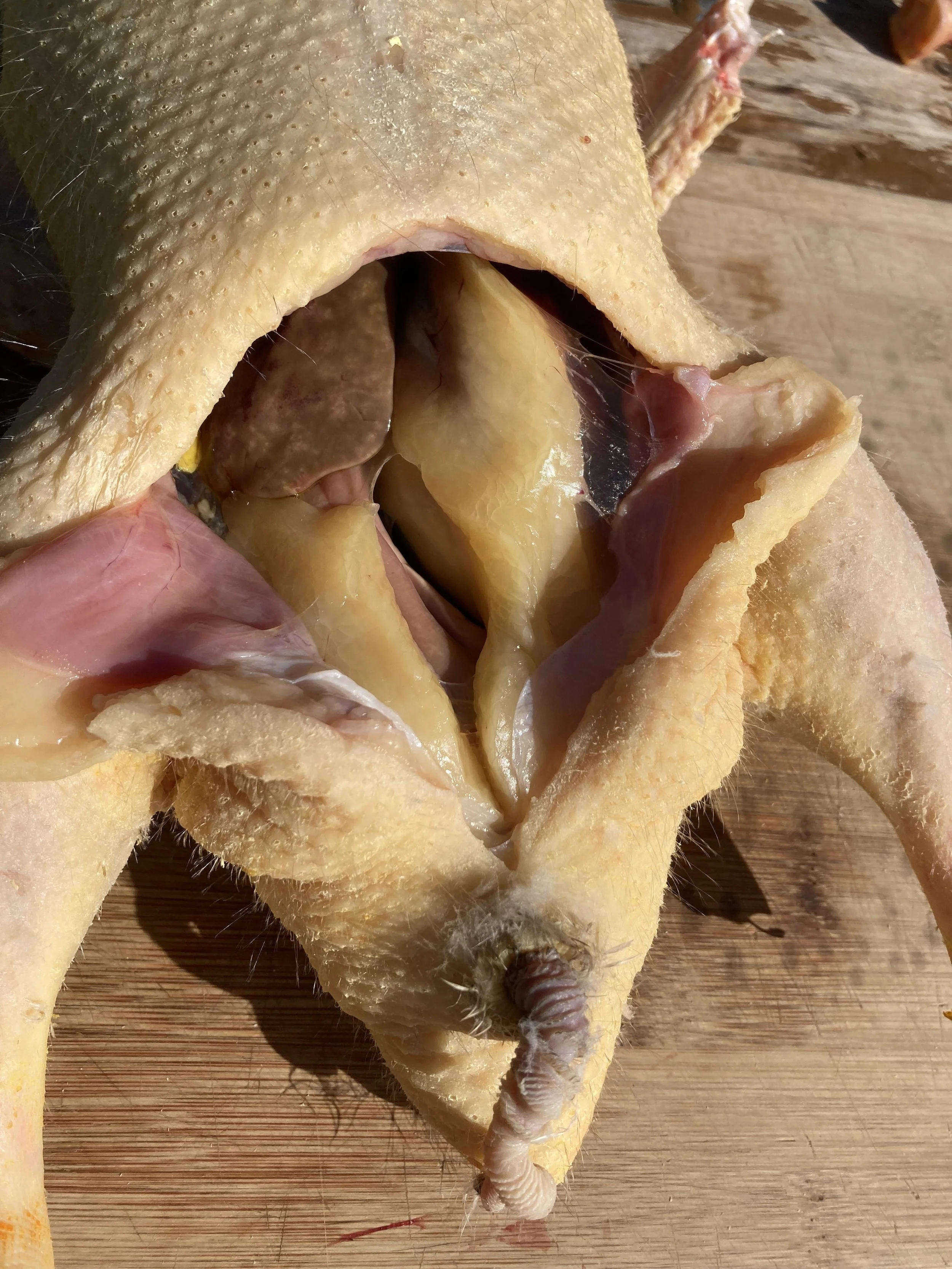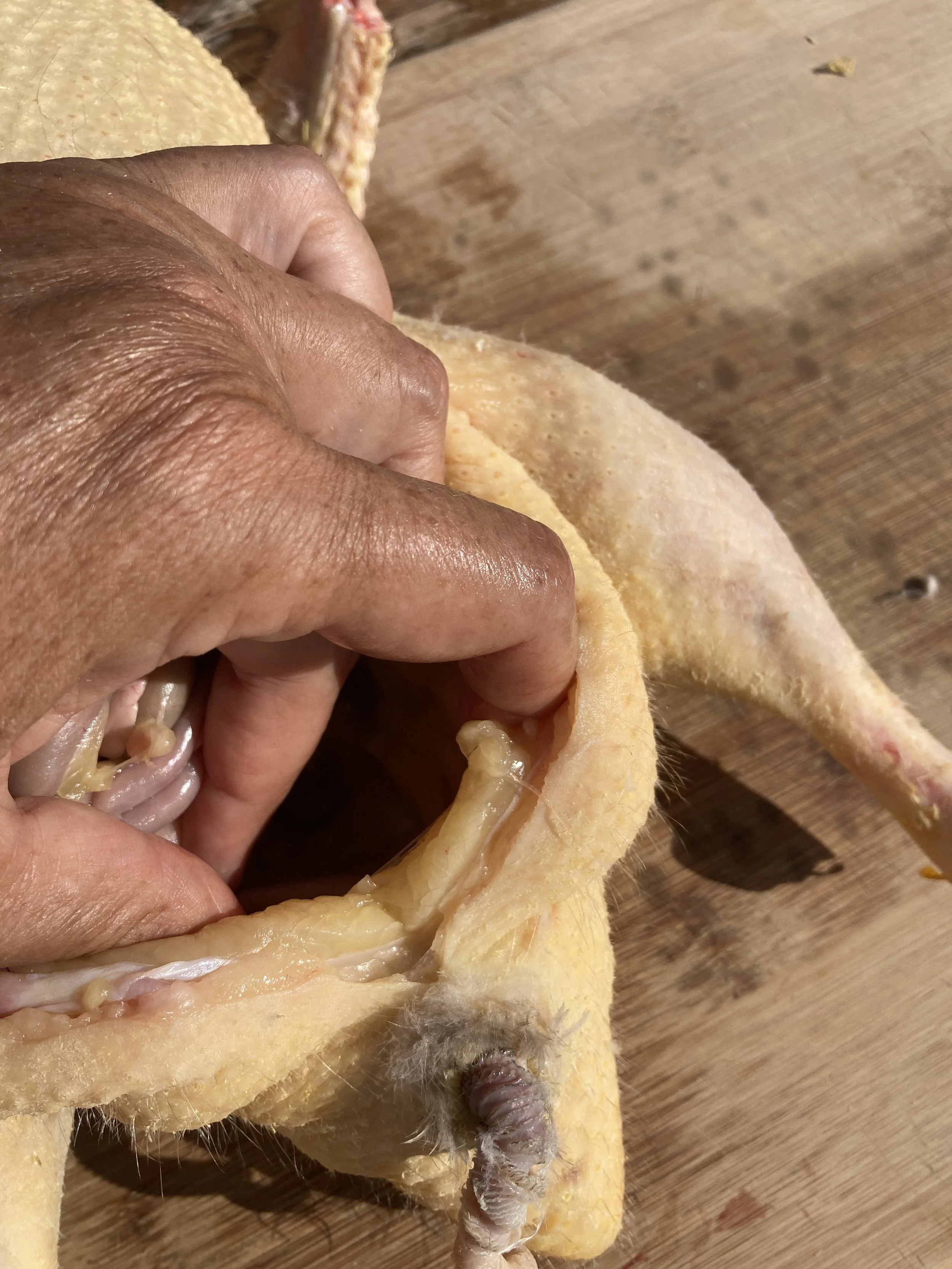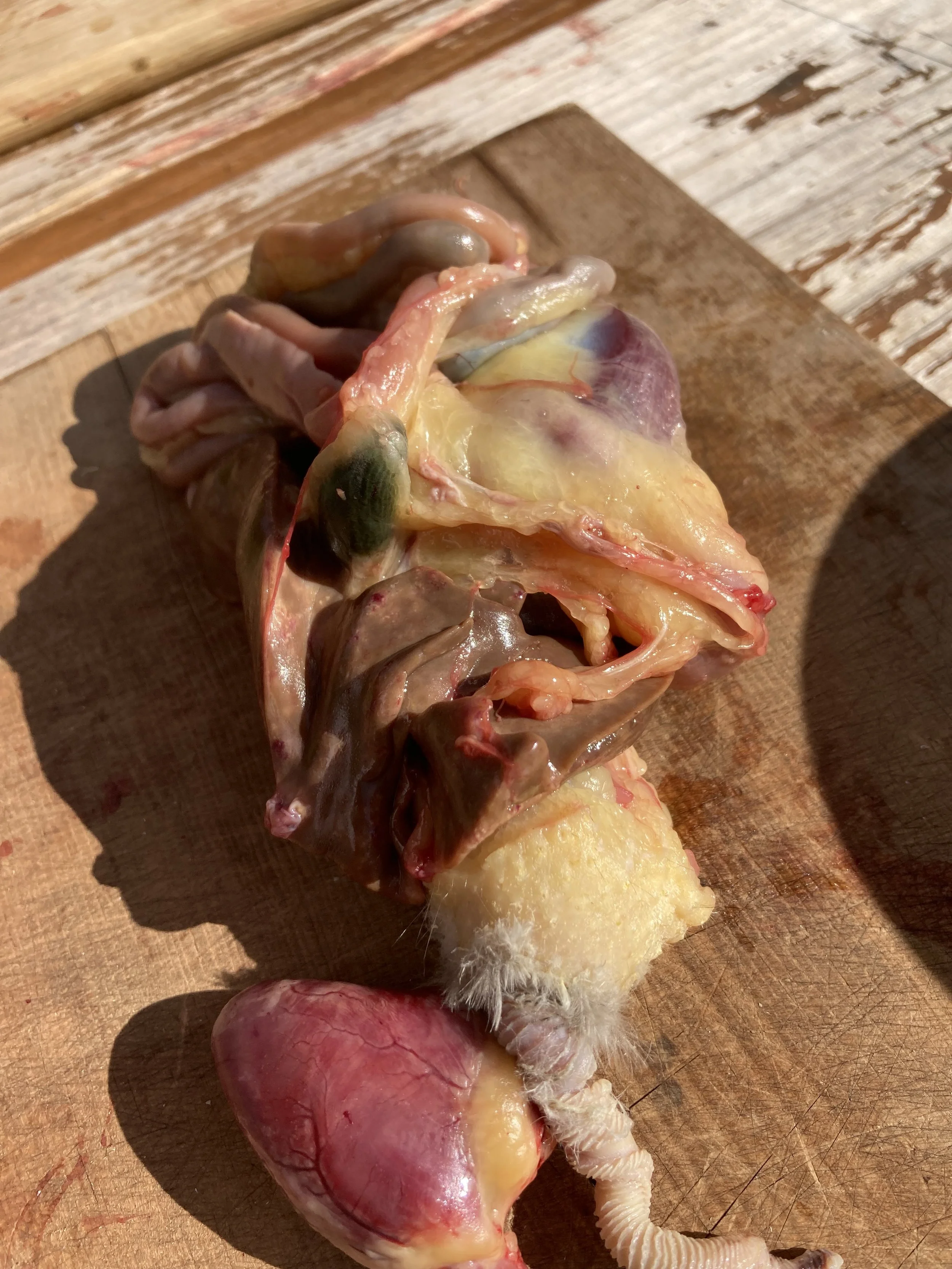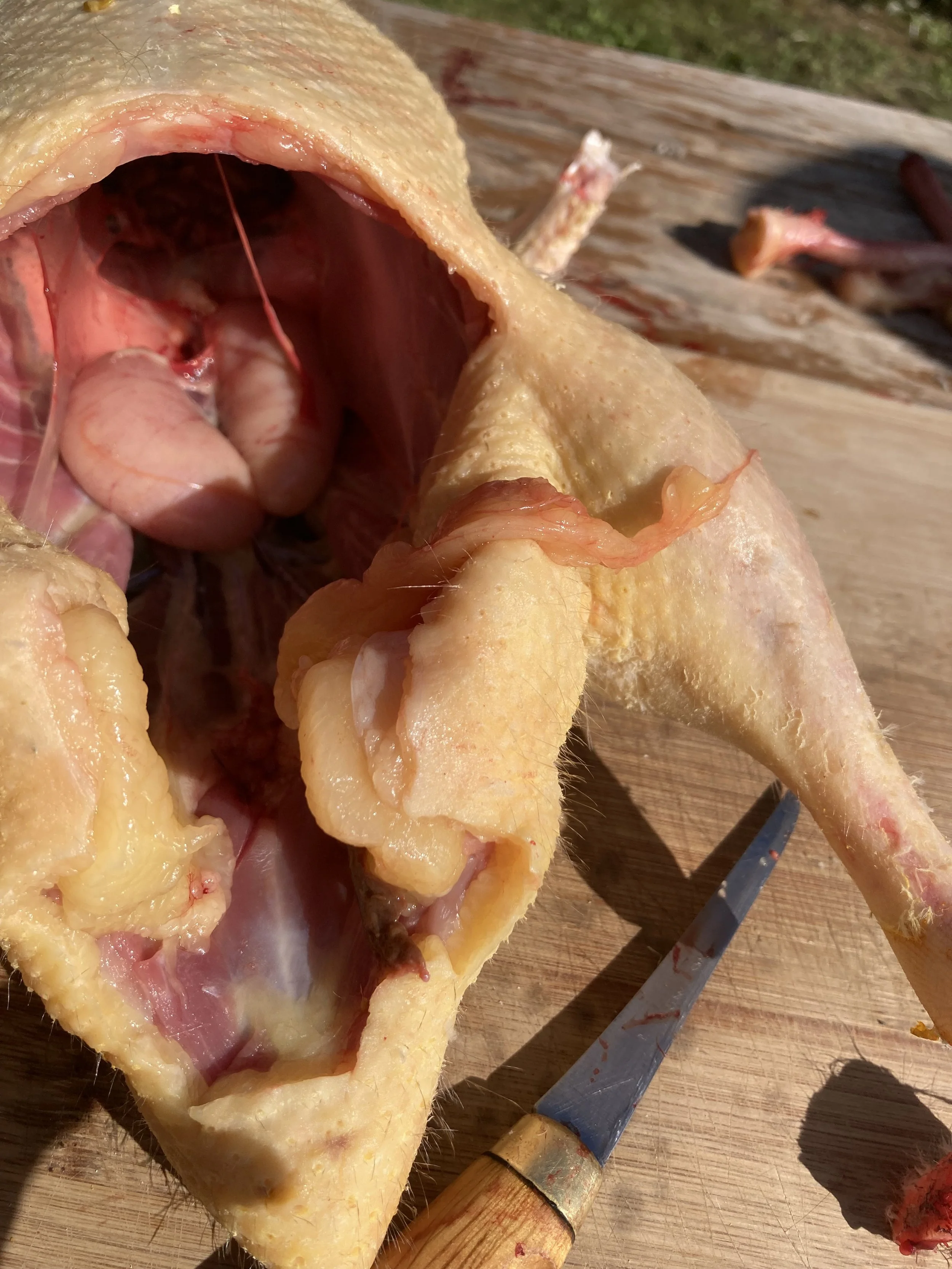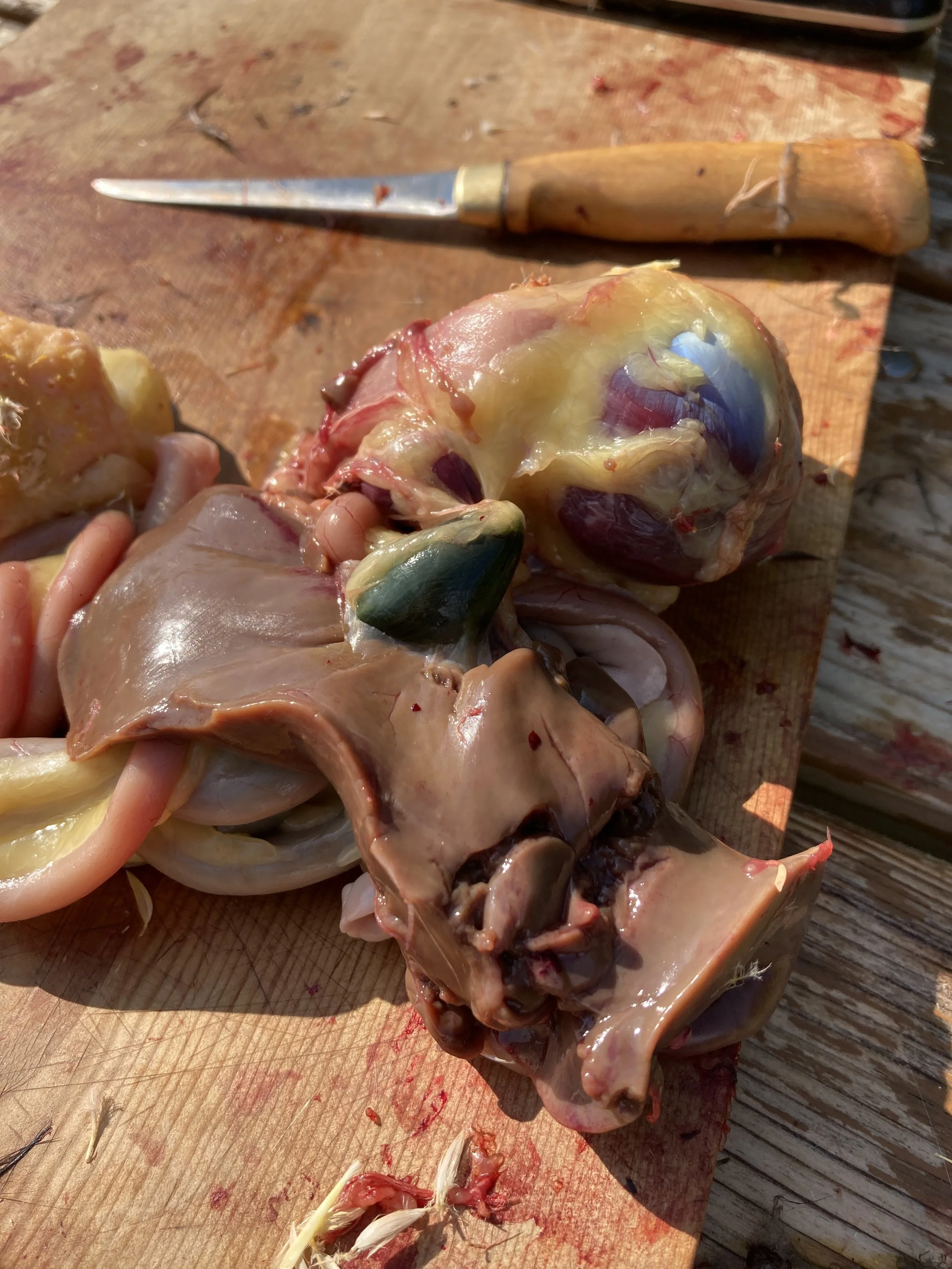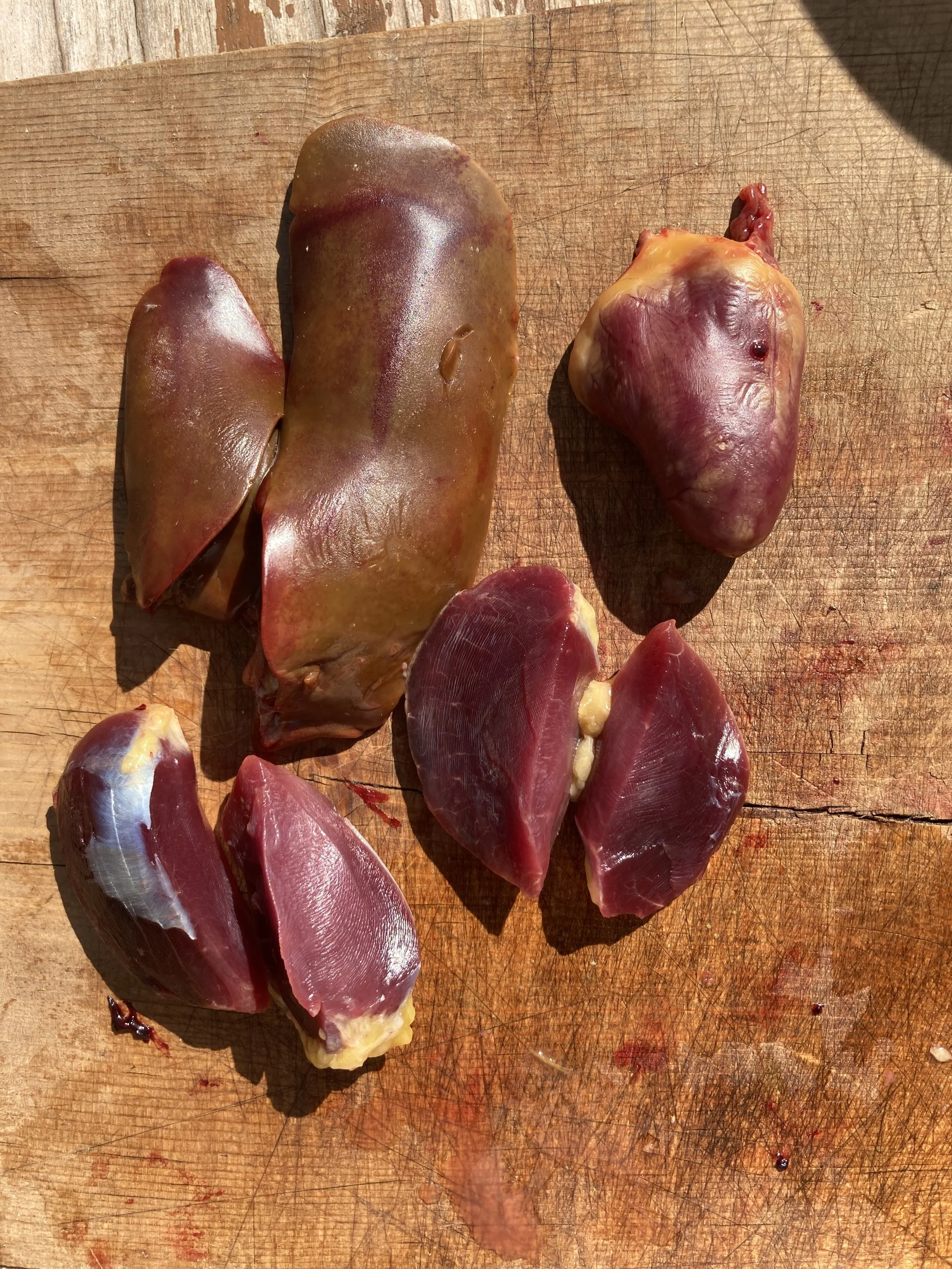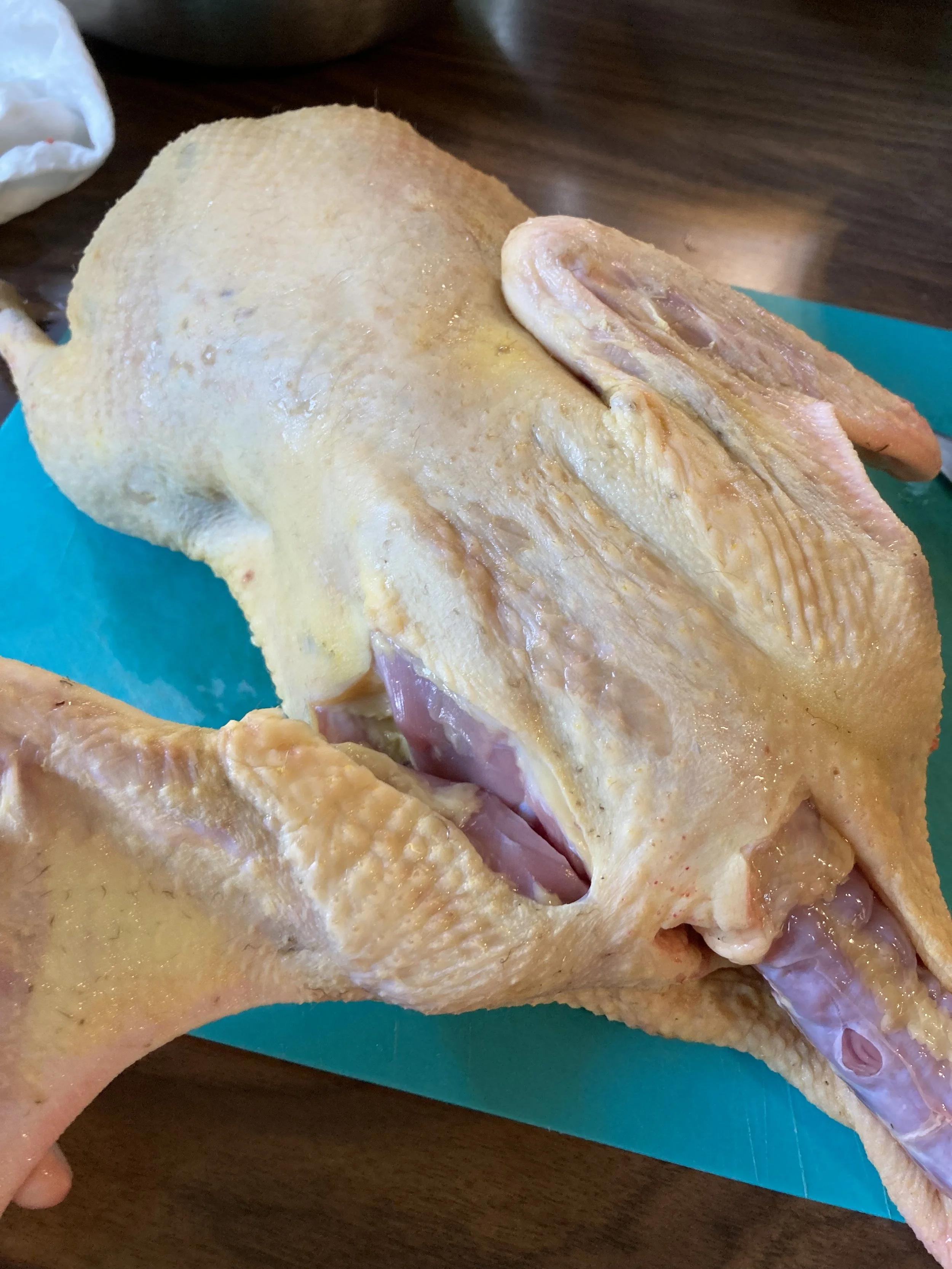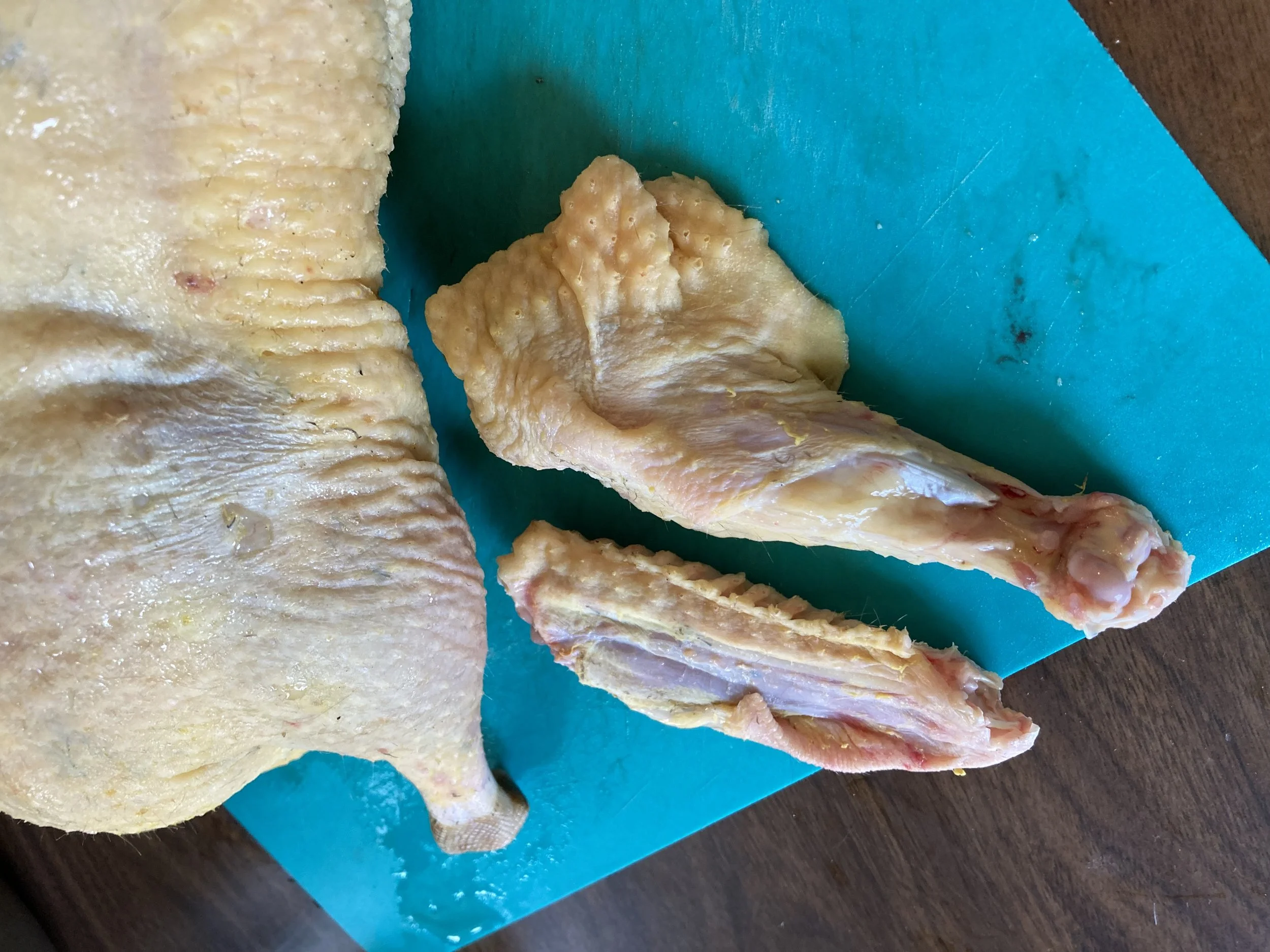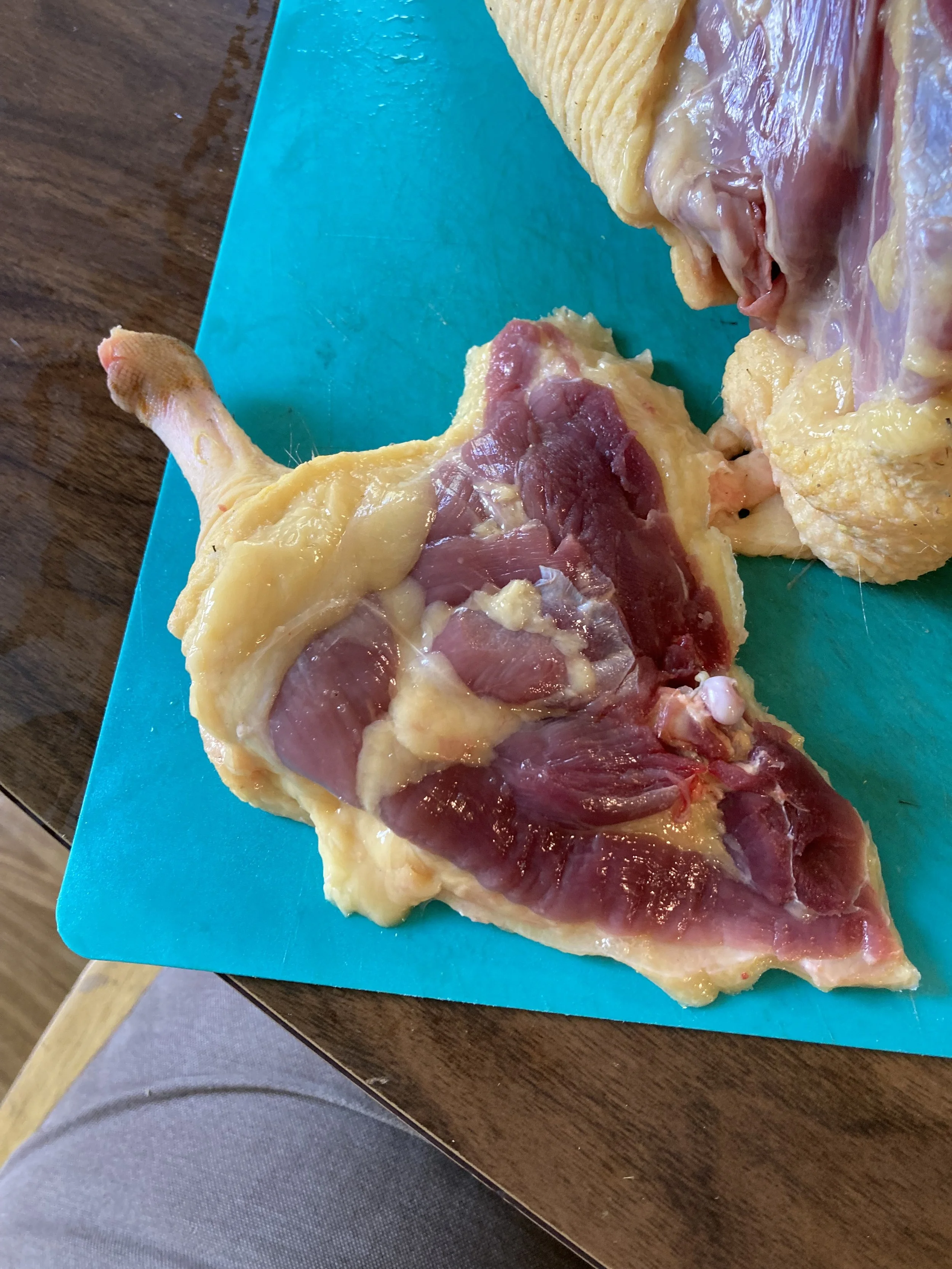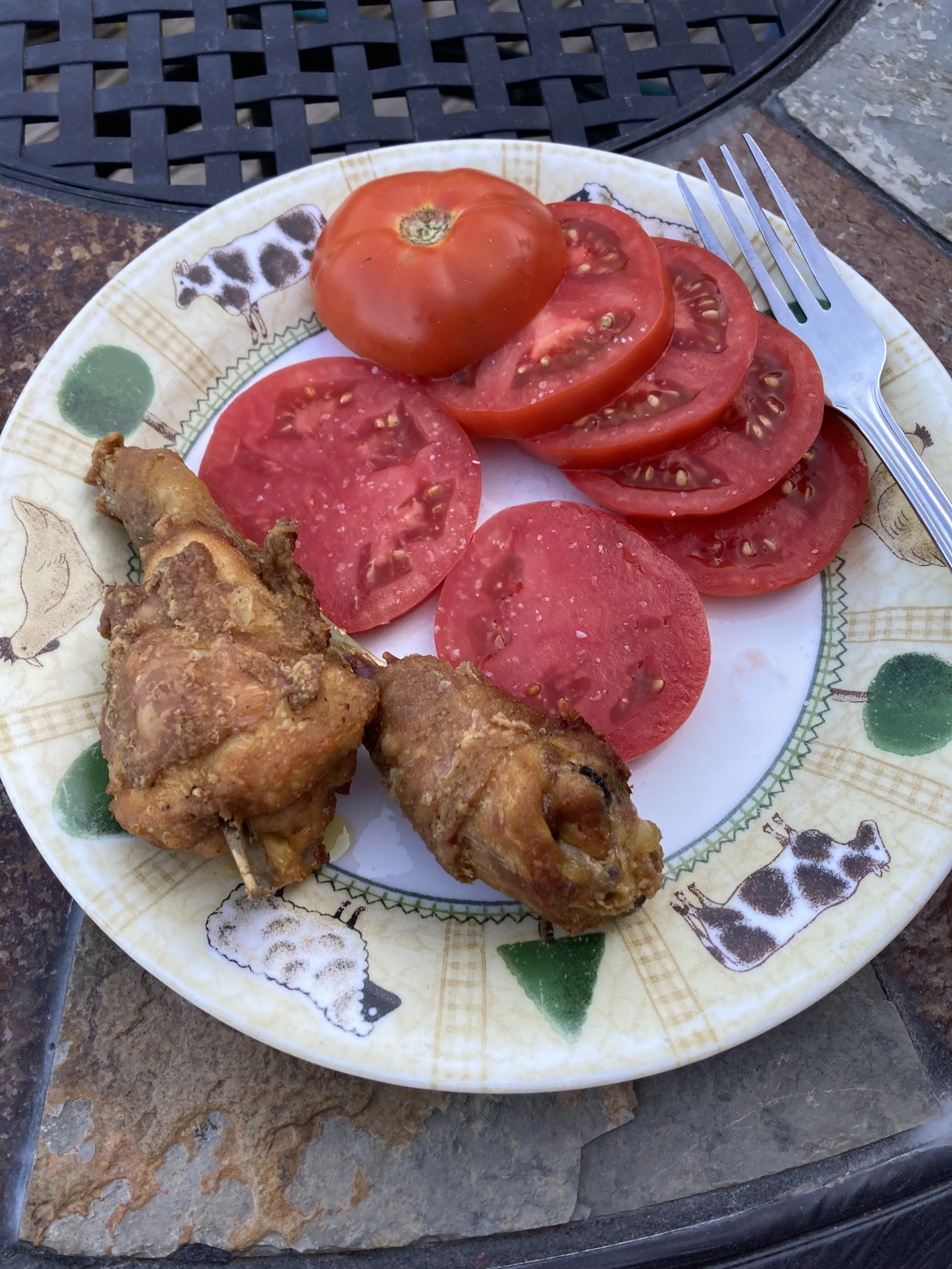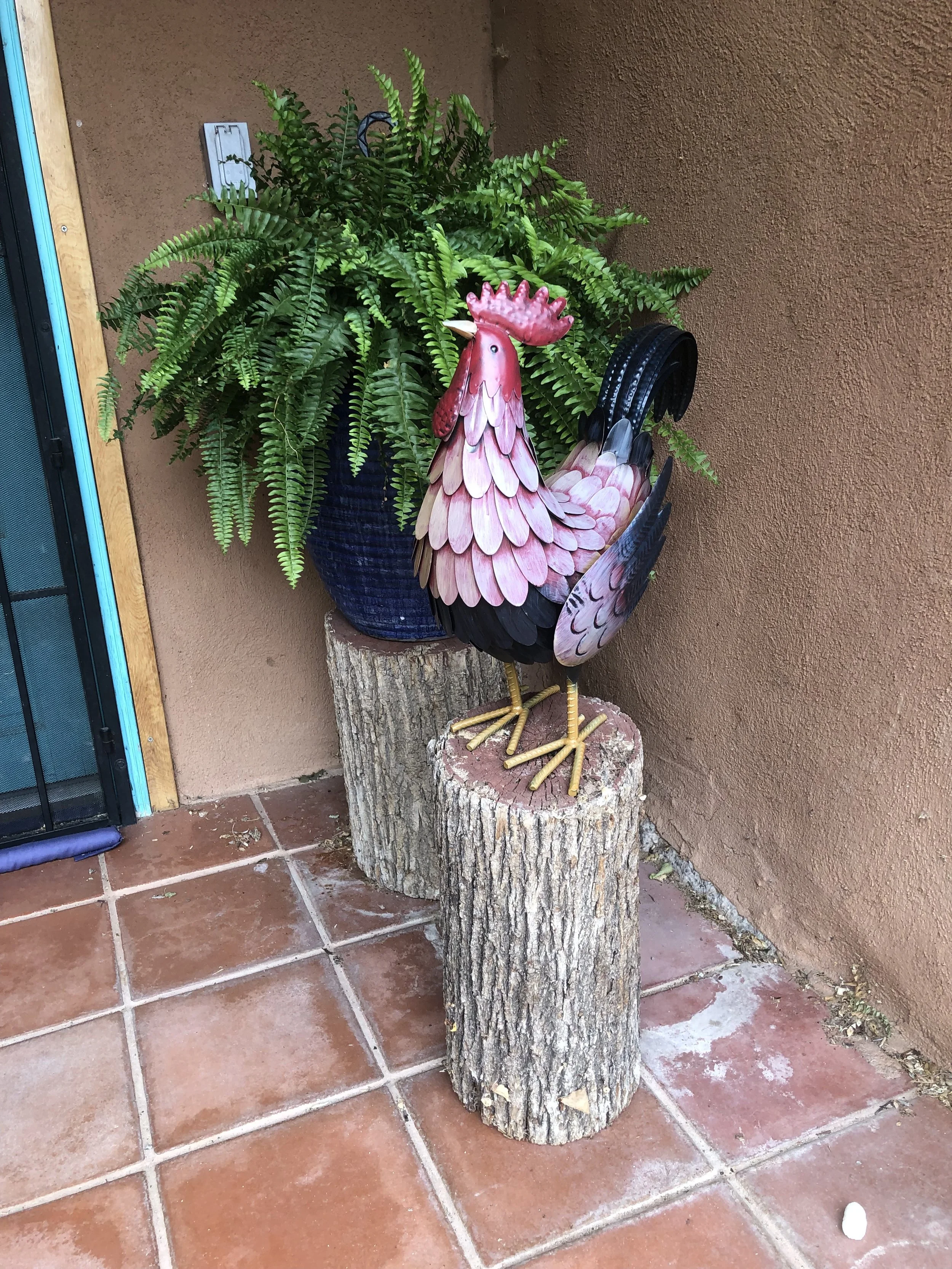Harvest journal: duck anatomy
We have been reducing our flocks. No more birds to harvest as of 8/21! The temperatures bouncing between chilly and muggy hot. We feel the pressure to squirrel produce away for winter.
Water plantain, pine boletes and chickory: all signs of fall. These are the buffer photos for those who do not care to see blood and gut photos. Frankly, I’m fascinated by the insides of my birds. One more buffer photo of a puffball and then onto the hard core farm life.
Michael uses a cleaver to chop off heads. I can never get a photo of the bagged bird, as I’m usually holding one and cooing to him while his companion goes to the block. Think of a pillow case with a corner removed. Head goes through the corner and the body is wrapped snugly with the bag. It keeps them still until the end. I stroke their breasts afterwards, which calms their bodies as they finish dying.
We hang birds from a gibbet, which also is a shooting bench, to let them finish bleeding before plucking. This is from earlier in the year when we harvested broilers.
This is a duck pizzle. Ducks will sometimes stick them out when going through the process of dying. Chickens never do. Ducks have a battle of the sexes going on. Hens have internal means of avoiding fertilization by undesirable males as they cannot avoid unwanted copulation. Too many drakes per hen will create undue stress, as will cold weather or unsafe lodging.
The eggs on the right side are normal. The ones on the left are not. We harvested three of our last year’s Khaki Campbells, even though we had some older hens in the flock. They lay a tannish egg, which was being scarce. They also were not overwintering well, due to their small size and producing less down than other hens. The stress factor may have led to the malfunction in their egg production. This will also happen as ducks grow older.
One of the three still had viable eggs. This one would have been laid, but for her being a member of the culled group. Because we pasture the birds and have common nests, we can’t keep track of who is laying, except by the color of the egg.
We submerge ducks in a big kettle of water heated to 160°-170° until the wing and tail feathers pull out easily. Sometimes the ducks are not done molting, which means there are feathers that have not quite emerged from their skin. You don’t want to save down from a duck during the molt, as you will have spiky things throughout the fluff.
After plucking (and saving down), I get to clean the birds. Duck and heritage chickens have narrow body cavities and I have smaller hands than Michael. I start by turning the bird on its breast and slitting the neck skin down to the shoulder blades.
Then I turn the bird over and separate the neck skin from the muscles. The trachea and esophagus need to be peeled off of the neck skin. Same for chickens, except they have a crop (feed sac) in the esophagus which is snuggled up to the top of the wish bone. It all has to come off as much as possible before removing the viscera from the abdomen.
This is a drake trachea. It has a large bulb where it adjoins the lungs. This gives drakes a very quiet quack.
This is a duck hen trachea. No box to dampen their quack. Hens are noisy!
Having removed the upper sections of breathing/feeding apparatus, I open up the body. I push down on the part just below the ribs to keep from puncturing any organs. Same for chickens.
There is a layer of skin, a layer of muscle and a layer of membrane and then internal fat deposits. It helps to have sharp knives.
The liver is in the upper left and the gizzard is hiding under the fat on the right.
I hold the intestines back from the abdominal wall while slicing down to and around the cloaca (the one hole where everything comes out).
After detaching the guts from the top and bottom, I reach into the cavity and detach all the membranes holding the guts in place. Then I grab hold of the esophagus and pull. The heart usually separates out, but the rest is held together by more membranes.
I have to detach the testes with a knife. Otherwise they are delicate and break into pieces. My chickens love these.
I carefully cut around the gall bladder, which is embedded in the liver. Gall is bitter and best kept contained. Sometimes I puncture the bladder and have to wash everything down.
The esophagus feeds into the gizzard, which acts like teeth for ducks and chickens.
It is lined with extremely tough skin. The bird swallows gravel, which gets ground with feed/grass/bugs/etc. The mash then goes into the intestines for final digestion.
I filet out the muscles to make into sausage.
These are the parts I save: liver, heart and gizzards. Hearts go to sausages too. We just eat the livers. I put all these in a small bowl when doing the outdoors portion of the harvest. One of my favorite things is opening the bowl indoors to do a final rinse before packaging. The sudden puff of meaty, bloody aroma is amazing. Heaven help me, I am a carnivore!
We pack the carcasses on ice in a cooler while doing the outdoors processing. We bring the cooler inside and Michael washes them down and removes any stray feathers, then hands them off to me. I part out the young ducks and skin and debone the sausage ducks. Duck breasts cook at a different rate than legs and wings. We prefer duck parts to whole roasted duck, due to cooking time differences, although a whole crispy duck is pretty special. I start the parting at the wing joints. Easiest to find from the back.
Wings and legs are best slow braised and then crisped under a broiler or on a grill. I toss the wing tips. Because ducks are so fatty, the skin doesn’t make good broth. The bones are very light and aren’t good for broth either. I save chicken carcasses for broth, but toss the ducks.
I take the legs off by slicing the skin along the muscle line and then slide my knife between the muscle and bone to the hip joint. I bend the hip until it pops out of the socket and continue the cut towards the tail.
Duck legs include the thighs. Braising helps render the fat out so they can crisp under high heat. Those legs get a work out and need slow cooking to become tender.
I bone the breast off last. There is a line along the skin that goes from bumpy to smooth. I slice along that line and slide my knife along the ribs to the central keel. Then I slice along the keel and the wishbone. A duck wishbone is “u” shaped, while a chicken or turkey has a “v” shaped wishbone.
Duck parts ready for packaging! I take all the meat and skin I can off the carcass for sausage making. Any extra skin/fat gets rendered for soap. The leftover cracklings are wonderful to snack on.
We also processed the extra young roosters and did in our old rooster. We fried one of the young ones. A rare treat! The old rooster will go to making sausage. He lost his place on our farm when we incubated 21 eggs and only 8 were fertile. When I opened him up, I found he had gotten so fat that he had almost blocked off his cloaca. Yikes! I could barely get my hand inside to clean him out. He was also very well connected. He weighed in at 8.5 pounds. The young cockerels weighed closer to 2 pounds each.
Julia Child said that she could become a great chef because she loved food and had no fear. I inherited my lack of fear from my mother. When she was young, she lived next to a woman who raised chickens but couldn’t kill them. My mother made a deal: she killed and cleaned two chickens and got to keep one to feed her family. I couldn’t resist sending her a rooster to protect her front door. I’m happy she likes Henry!
